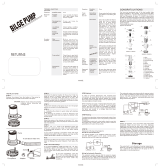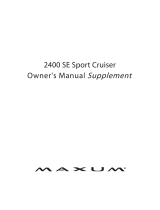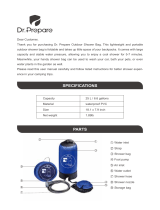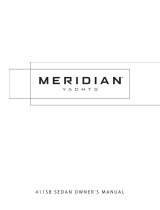Page is loading ...



Date of Purchase: _________________________________________________
Engine Serial Number: _____________________________________________
Hull Identification Number:__________________________________________
Hull Identification Number
The Hull Identification Number (HIN) is located just below the
deck gunnel at the starboard aft corner of the boat.
Record the HIN (and the engine serial number) in the space
provided above.
Include the HIN with any correspondence or orders.
© 2011 Bayliner Technical Publications. All rights reserved.
No part of this publication may be reproduced, stored in any retrieval system, or transmitted in any form by any means, electronic, mechanical, photocopying,
recording or otherwise, without prior written permission of Bayliner.
Printed in the United States of America.
General Notes
The material in this document is for information only and is subject to change without notice. While reasonable efforts have been made in the preparation of this
document to assure its accuracy, Bayliner assumes no liability resulting from errors or omissions in this document, or from the use of information contained herein.
Due to our commitment to product improvement, Bayliner reserves the right to make changes in the product design, specifications, and equipment at any time
without notice or obligation. Illustrations and/or photos may show optional equipment.
All Bayliner products meet or exceed USCG (United States Coast Guard) and/or NMMA (National Marine Manufacturer’s Association) construction standards.
Manufactured with 1,1,1 Trichloroethane, a substance which harms public health and environment during the manufacturing process by destroying ozone in the
upper atmosphere.
Proprietary Rights
This document discloses subject matter in which Bayliner has proprietary rights. The information and design disclosed herein were originated by and are the prop-
erty of Bayliner. Neither receipt nor possession thereof confers or transfers any right to reproduce, copy, alter or disclose the document or any part thereof, any
information contained therein, or to construct boats or any item from it, except by written permission from or written agreement with Bayliner. This document is to
be returned upon request to Bayliner.

CONTENTS
Chapter 1: Welcome Aboard! 1
Dealer Service 1
Warranty Information 1
Boating Experience 1
Safety Standards 2
Qualified Maintenance 3
Special Care for Moored Boats 3
Engine & Accessory Guidelines & Literature 4
Propeller 4
Basic Boat Dimensions & Capacities 5
Extended Swim Platform Structural Limitations 5
Boat Lifting 6
Carbon Monoxide (CO) 7
CO Facts 7
Factors that Increase the Effects of CO Poisoning 7
Where & How CO Can Accumulate 8
How to Protect Yourself & Others From CO 9
CO Checklists 9
CO Monitors 10
More Information 10
Chapter 2: Locations 11
Exterior Views 11
Hull Views 11
Deck View 12
Helm 13
Warning Labels 14
Helm Area & Forward Deck 14
Cockpit & Aft Deck 15
Interior Areas 16
Component Locations 17
Chapter 3: Propulsion & Related Systems 23
Fire Extinguisher Port 23
Engine 24
Bilge Blower System 24
Fuel System 25
Fuel Fill & Vent 26
Anti-siphon Valve (Gas Engine Only) 26
Gas Engine Fuel Filters 27
Diesel Engine Fuel Filter/Water Separator 27
Chapter 4: Controls & Gauges 28
Steering 28
Shift/Throttle Controls 28
Power Trim & Tilt 28
Trim Tabs 28
Bow Thruster (If Equipped) 28
Gauges 29
Cleaning the Gauges 29
Gauge Fogging 29
Radio Transmission Interference 29
Fuel Gauge 29
Chapter 5: Navigation &
Communication Equipment 30
Depth Finder 30
VHF Radio (If Equipped) 30
Global Positioning System (GPS) (If Equipped) 30
Chapter 6: Plumbing 31
Bilge Pumps 31
Bilge Pump Testing 32
Built-in Autofloat Switch Testing 32
Seawater Systems 33
Seacocks 33
Seawater Strainers 33
Freshwater System 34
Transom Shower 34
Freshwater System Winterization 35
Water Heater (If Equipped) 36
Winterizing the Water Heater 37
Preparing the Water Heater for Use After Winterizing 38
Drain Systems 39
Deck Drains 39
Sink Drains 39
Shower Drain System (If Equipped) 39
Marine Head & Holding Tank 40
Winterizing the System 40
Holding Tank Cleaning Tip 40
Manual Flush Head (If Equipped) 41
Vacuum Flush Head System (If Equipped) 42
Macerator (If Equipped) 43
Air Conditioner (If Equipped) 44

Chapter 7: Deck Equipment 45
Cleats & Bow/Stern Eyes 45
Windlass (If Equipped) 45
Canvas & Vinyl Tops & Enclosures 46
Canvas Care 46
Clear Vinyl Care 47
Chapter 8: Appliances &
Entertainment Systems 49
Alcohol/110-Volt Electric Stove (If Equipped) 49
Refrigerator (If Equipped) 50
Audio Equipment 50
Chapter 9: Lights 51
Care & Maintenance 51
Interior & Exterior Lights 51
Spotlight (If Equipped) 51
Navigation Lights 51
Chapter 10: Electrical System 52
12-Volt DC System 53
Batteries 53
Battery Switch 53
Battery Switch Positions 53
Fuses & Circuit Breakers 54
12-Volt DC Accessory Outlets 54
Alternator 54
Battery Charger 54
110-Volt AC System 55
Shore Power 56
Connecting to Shore Power 57
Parallel Switch 57
Generator 58
Electrical Harnesses & Schematics 60
120V Single Shore Power AC Panel 60
120V Single Shore Power Architecture 64
120V Single Shore Power w/Generator Architecture 65
120V Dual Shore Power Architecture 66
120V Dual Shore Power w/Generator Architecture 67
12V Deck Harness 68
12V Hull Harness 69
12V Helm Harness 70
12V Galley Harness 71
12V Engine Harness 71
12V Breaker Panel Harness 72
12V Head Harness 73
Important Records 74
Float Plan 75

Hazard Boxes & Symbols
The hazard boxes and symbols shown below are used throughout this supplement to call attention to potentially dan-
gerous situations which could lead to either personal injury or product damage. Read all warnings carefully and fol-
low all safety instructions.
This box alerts you to immediate hazards which WILL cause severe personal injury or death if
the warning is ignored.
DANGER!
!
This box alerts you to hazards or unsafe practices which COULD result in severe personal
injury or death if the warning is ignored.
WARNING!
!
This box alerts you to hazards or unsafe practices which COULD result in minor personal
injury or cause product or property damage if the warning is ignored.
CAUTION
!
This box calls attention to installation, operation or maintenance information, which is impor-
tant to proper operation but is not hazard related.
NOTICE
CO POISONING
HAZARD!
EXPLOSION
HAZARD!
NO OPEN
FLAME!
HOT
HAZARD!
ROTATING
PROPELLER HAZARD!
FALLING
HAZARD!
ELECTRICAL
HAZARD!
FIRE
HAZARD!
RUN BILGE BLOWERS
FOR 4 MINUTES!

285 Cruiser • Owner’s Manual Supplement
1
Chapter 1: Welcome Aboard!
This Owner’s Manual Supplement provides specific information about your boat that is not covered in the Cruiser
& Yacht Owner’s Manual.
The Cruiser & Yacht Owner’s Manual contains general information about safe operating practices, general boat-
ing regulations, and general maintenance techniques. Information that is more specific to your particular boat is
found in this Owner’s Manual Supplement.
Before using your boat, study this Owner’s Manual Supplement, the Cruiser & Yacht Owner’s Manual, and all
engine and accessory literature carefully. If similar instructions are found in more than one manual, always refer
to the specific manufacturer’s manual (such as the engine manual) for the most complete and
accurate information.
Keep this Owner’s Manual Supplement and the Cruiser & Yacht Owner’s Manual on your boat in a secure, yet
readily available place.
Dealer Service
Your dealer is your key to service.
Ask your dealer to explain all systems before taking delivery of your boat.
Contact your dealer if you have any problems with your new boat.
If your dealer cannot help, call our customer service hotline: 360-435-8957 or send us a FAX: 360-403-4235.
Buy replacement parts from any authorized Bayliner dealer.
You can access on-line parts catalogs, links to vendor websites, and other helpful features by logging on
to www.baylinercustomercare.com.
Warranty Information
Bayliner offers a Limited Warranty on each new Bayliner purchased through an authorized Bayliner dealer.
A copy of the Limited Warranty was included in your owner’s packet.
If you did not get a copy of the Limited Warranty, please contact your Bayliner dealer or call 360-435-8957 for
a copy.
Boating Experience
If this is your first boat or if you are changing to a type of boat you are not familiar with, for your own comfort and
safety, get handling and operating experience before assuming command of your boat.
Take one of the boating safety classes offered by the U.S. Power Squadrons or the U.S. Coast Guard Auxiliary. For
more course information, including dates and locations of upcoming classes, contact the organizations directly:
U.S. Power Squadrons: 1-888-FOR-USPS (1-888-367-8777) or on the Internet at: www.usps.org
In Canada, for the CPS courses call 1-888-CPS-BOAT.
U.S. Coast Guard Auxiliary: 1-800-368-5647 or on the Internet at: www.cgaux.org
Outside the United States, your selling dealer, national sailing federation, or local boat club can advise you of local
sea schools or competent instructors.
CONTROL HAZARD!
An experienced operator MUST be in control of your boat at ALL times. Do NOT operate your
boat while under the influence of alcohol or drugs.
WARNING!
!

Chapter 1: Welcome Aboard! 285 Cruiser • Owner’s Manual Supplement
2
Safety Standards
FALLING & ROTATING PROPELLER HAZARD!
NEVER allow anyone to ride on parts of your
boat NOT designed for such use.
Sitting on seat-backs, lounging on the forward
deck, bow riding, gunwale riding or occupying
the transom platform while underway is espe-
cially hazardous and WILL cause personal
injury or death.
DANGER!
!
FALLING, ROTATING PROPELLER & CARBON
MONOXIDE POISONING HAZARD!
NEVER allow anyone to occupy, or hang from,
the back deck or transom platform while the
engine is running.
Teak surfing, dragging, or water skiing within
20 feet of a moving watercraft can be fatal.
PERSONAL SAFETY HAZARD!
ALWAYS secure the anchor and other loose
objects BEFORE getting underway.
The anchor and other items that are NOT
properly secured can come loose when your
boat is moving and cause personal injury or
death.

285 Cruiser • Owner’s Manual Supplement Chapter 1: Welcome Aboard!
3
Your boat’s mechanical and electrical systems were designed to meet all safety standards in effect at the time it was
built. These standards help insure your safety and the safety of other people, vessels and property.
Read this supplement, the Cruiser & Yacht Owner’s Manual, the engine owner’s manual, and all accessory instruc-
tions for important safety standards and hazard information.
Qualified Maintenance
Failure to maintain your boat’s systems (listed in the warning above) as designed could violate the laws in your juris-
diction and could expose yourself and others to the danger of bodily injury or accidental death.
Follow the maintenance instructions in:
Special Care for Moored Boats
While moored, your boat’s hull bottom will collect marine growth that not only looks bad, but also reduces perfor-
mance, and could damage the gelcoat.
As often as needed for your area, haul your boat out of the water and scrub the hull bottom with a bristle brush and
soap and water.
A wide variety of components used on this vessel contain or emit chemicals known to the State
of California to cause cancer and birth defects and other reproductive harm.
Examples Include:
Engine and generator exhaust
Engine/generator fuel, and other liquids such as coolants and oil, especially used motor oil
Cooking fuels
Cleaners, paints, and substances used for vessel repair
Waste materials that result from wear of vessel components
Lead from battery terminals and from other sources such as ballast or fishing sinkers
To Avoid Harm:
Keep away from engine, generator, and cooking fuel exhaust fumes.
Wash exposed skin thoroughly with soap and water after handling the substances above.
WARNING!
!
To maintain the safety of your boat, allow ONLY trained personnel to work on, or change in
any way, the:
Steering System
Propulsion System
Engine Control System
Fuel System
Environmental Control
System
Electrical System
Navigation System
CO Monitor(s)
WARNING!
!
This Owner’s Manual Supplement
The Cruiser & Yacht Owner’s Manual
The engine owner’s manual, and;
All accessory literature.
Applying an epoxy barrier coating to the hull bottom will help prevent gel coat blistering
while your boat is moored.
Cover the barrier coating with several coats of anti-fouling paint.
Many states have environmental standards regulating the chemical content of bottom
paints. Your local dealer can recommend bottom paints approved for use in your state.
NOTICE

Chapter 1: Welcome Aboard! 285 Cruiser • Owner’s Manual Supplement
4
Engine & Accessory Guidelines & Literature
Your boat’s engine and accessories were selected to provide optimum performance and service.
Installing a different engine or adding accessories may affect your boat’s running trim.
If you choose to install a different engine or add accessories that may affect your boat’s running trim, have a
trained marine technician perform a safety inspection and handling test before using your boat again.
The engine and accessories on your boat have their own manuals. Read these manuals before using the engine and
accessories.
Unless noted otherwise, all engine and accessory literature referred to in this supplement is included in your owner’s
packet.
While the topics listed below may be included in this supplement and in the Cruiser & Yacht Owner’s Manual,
always refer to the engine manual first for specific information on these important subjects:
Propeller
Keep the propeller in good repair and at the correct pitch for your particular situation.
A slightly bent or nicked propeller will adversely affect the performance of your boat.
BEFORE starting or working on your engine, read the engine manual.
BEFORE using the accessories on your boat, read the accessory manuals.
BEFORE storing your boat, refer to your engine and accessory manuals for storage/winter-
ization instructions.
Certain modifications to your boat WILL result in cancellation of your warranty protection.
ALWAYS check with your dealer BEFORE making any modifications to your boat.
NOTICE
Engine Break-in Procedure
Engine Starting and Stopping
Gear Shifting
Fuel and Oil Recommendations
Engine Maintenance
Engine Storage/Winterization
ENGINE DAMAGE HAZARD!
The factory standard propeller may not be the best for your particular boat and load condi-
tions. Refer to the engine manual for engine RPM ratings. The engine should reach, but not
exceed its full rated RPM when full-throttle is applied.
Immediately contact your local Bayliner dealer if:
The engine cannot reach its full rated RPM when full-throttle is applied, or;
The engine exceeds its full rated RPM when full-throttle is applied.
CAUTION
!

285 Cruiser • Owner’s Manual Supplement Chapter 1: Welcome Aboard!
5
Basic Boat Dimensions & Capacities
Extended Swim Platform Structural Limitations
The extended swim platform is designed to be lightweight for proper boat balance. The load limit for the extended
swim platform is 30 pounds per square foot, evenly distributed.
(A) Overall Length . . . . . . . . . . . . . .28' 7" 8.71 m
With Opt. Swim Platform. . . . . . . . . .31'1" 9.47 m
(B) Beam (Width). . . . . . . . . . . . . . . .9' 11" 3.02 m
(C) Draft (Stern Drive Down) . . . . . .39.5"* 100.3 cm*
(D) Draft (Stern Drive Up). . . . . . . . .25"* 63.5 cm*
(E) Overall Height . . . . . . . . . . . . . . .13' 5" 4.08 m
(F) Waterline to Top of Arch . . . . . . .10' 1" 3.07 m
(G) Waterline to Top of Windshield. .6' 9" 2.05 m
* MINIMUM WATER DEPTH TO PREVENT RUNNING AGROUND
Dry Weight. . . . . . . . . . . . . . . . . . . . . 7,867 lbs. 3,568 kg.
Fuel Capacity. . . . . . . . . . . . . . . . . . . 89 gal. 337 liters
Holding Tank Capacity . . . . . . . . . . . 30 gal. 114 liters
Water Capacity. . . . . . . . . . . . . . . . . . 28 gal. 106 liters
Dead Rise. . . . . . . . . . . . . . . . . . . . . . 17°

Chapter 1: Welcome Aboard! 285 Cruiser • Owner’s Manual Supplement
6
Boat Lifting
Always follow the lift equipment’s instructions and requirements.
When lifting your boat, always position the lifting slings at the forward and aft lifting sling label positions.
PERSONAL INJURY and/or PRODUCT or PROPERTY DAMAGE HAZARD!
Lifting slings can slip on the hull, which could cause serious injury or death.
ALWAYS secure the forward lifting sling to the aft lifting sling BEFORE lifting. This will
reduce the risk of sling slippage.
WARNING!
!
PERSONAL INJURY and/or PRODUCT or PROPERTY DAMAGE HAZARD!
NEVER lift any boat using the cleats, or the bow/stern eyes.
WARNING!
!
PERSONAL INJURY and/or PRODUCT or PROPERTY DAMAGE HAZARD!
Water in the bilge can shift and change the balance of the load.
If water is present in the bilge, pump or drain the water out of the bilge areas BEFORE lift-
ing your boat.
WARNING!
!
PRODUCT or PROPERTY DAMAGE HAZARD!
When lifting any boat, ALWAYS use a spreader bar.
The spreader bar MUST be equal to the width of the boat at each lifting point.
Make sure your boat remains level during lifting. The engine can be damaged by water
ingestion if the stern is lifted higher than the bow.
CAUTION
!

285 Cruiser • Owner’s Manual Supplement Chapter 1: Welcome Aboard!
7
Carbon Monoxide (CO)
CO Facts
CO poisoning causes a significant number of boating deaths each year.
Called the "silent killer", CO is an extremely toxic, colorless, odorless and tasteless gas.
CO can harm or even kill you inside or outside your boat.
CO can affect you whether you’re underway, moored, or anchored.
CO symptoms are similar to seasickness or alcohol intoxication.
CO can make you sick in seconds. In high enough concentrations, even a few breaths can be fatal.
Breathing CO blocks the ability of your blood to carry oxygen.
The effects are cumulative. Even low levels of exposure can result in injury or death.
Factors that Increase the Effects of CO Poisoning
Age
Smokers or people exposed to high concentrations of cigarette smoke
Consumption of alcohol
Lung disorders
Heart problems
Pregnancy
Carbon monoxide gas (CO) is colorless, odorless, tasteless, and
extremely dangerous.
ALL engines, generators, and fuel burning appliances produce CO
as exhaust.
Prolonged exposure to low concentrations or very quick exposure to high
concentrations WILL cause BRAIN DAMAGE or DEATH.
Teak surfing, dragging, or water skiing within 20 feet of a moving water-
craft can be fatal.
DANGER!
!
CARBON MONOXIDE POISONING HAZARD!
NEVER use full canvas and vinyl enclosures when the engine or generator
is running.
For proper fresh air circulation, remove forward, aft, and both side enclo-
sure curtains BEFORE starting the engine or generator.
DANGER!
!

Chapter 1: Welcome Aboard! 285 Cruiser • Owner’s Manual Supplement
8
Where & How CO Can Accumulate
Stationary conditions that increase CO accumulations include:
To correct these stationary conditions:
Close all windows, portlights and hatches.
If possible, move your boat away from source of CO.
Remove forward, aft, and both side enclosure curtains BEFORE starting the engine or generator.
Running conditions that increase CO accumulations include:
To correct these running conditions:
Trim bow down.
Open windows and canvas.
When possible, run boat so that prevailing winds help dissipate exhaust.
Using engine, generator, or other fuel burning device
when boat is moored in a confined space.
Mooring too close to another boat that is using its
engine, generator, or other fuel burning device.
Running your engine or generator with full canvas
and vinyl enclosures installed.
Running boat with trim angle of bow too high. Running boat without through ventilation
(station wagon effect).

285 Cruiser • Owner’s Manual Supplement Chapter 1: Welcome Aboard!
9
How to Protect Yourself & Others From CO
Know where and how CO may accumulate in and around your boat (see previous page).
Stay away from the transom while the vessel is idling or underway – The transom is where carbon monoxide col-
lects while idling or underway.
Avoid Other Idling Vessels – Idling vessels produce concentrated levels of carbon monoxide.
Always maintain fresh air circulation throughout your boat.
Know where your engine and generator exhaust outlets are located and keep everyone away from these areas.
Never sit on, or hang onto, the back deck or transom platform while the engine is running.
Never enter the areas under transom platforms where exhaust outlets are located.
Although CO can be present without the smell of exhaust fumes, if exhaust fumes are detected on your boat, take
immediate action to dissipate these fumes.
Treat symptoms of seasickness as possible CO poisoning. Get the person into fresh air immediately. Seek medical
attention—unless you’re sure it’s not CO.
Maintain the CO monitors that were installed inside your boat. Never ignore any alarm. Replace monitors as
recommended by the monitor manufacturer.
Follow the CO checklists provided below.
Get a Vessel Safety Check.
For information on how to get a free VESSEL SAFETY CHECK, visit www.vesselsafetycheck.org or contact your
local U.S. Coast Guard Auxiliary or United States Power Squadrons®.
U.S. Coast Guard Auxiliary: 800-368-5647 or online at: www.cgaux.org
U.S. Power Squadrons: 888-367-8777 or online at: www.usps.org
CO Checklists
Trip Checklist
Make sure you know where the exhaust outlets are located on your boat.
Educate all passengers about the symptoms of CO poisoning and where CO may accumulate.
When docked, or rafted with another boat, be aware of exhaust emissions from the other boat.
Listen for any change in exhaust sound, which could mean an exhaust component failure.
Test the operation of each CO monitor by pressing the test button.
Monthly Checklist
Make sure all exhaust clamps are in place and secure.
Look for exhaust leaking from exhaust system components. Signs include rust and/or black streaking, water
leaks, or corroded or cracked fittings.
Inspect rubber exhaust hoses for burned, cracked, or deteriorated sections. All rubber hoses should be pliable and
free of kinks.
Annual Checklist
Have a Trained Marine Technician:
Replace exhaust hoses if cracking, charring, or deterioration is found.
Ensure that your engines and generators are properly tuned, and well maintained.
Inspect each water pump impeller and the water pump housing. Replace if worn. Make sure cooling systems are
in working condition.
Inspect all metallic exhaust components for cracking, rusting, leaking, or loosening. Make sure they check the
cylinder head gasket, exhaust manifold, water injection elbow, and the threaded adapter nipple between the
manifold and the elbow.
Clean, inspect, and confirm proper operation of the generator cooling water anti-siphon valve (if equipped).

Chapter 1: Welcome Aboard! 285 Cruiser • Owner’s Manual Supplement
10
CO Monitors
Do not disconnect the CO monitors.
Read the manufacturer’s instructions for your CO monitors. If you did not receive the manufacturer’s instruc-
tions, call (800) 383-0269 and they will be mailed to you.
More Information
For more information about preventing carbon monoxide poisoning on recreational boats and other boating safety
tips, contact:
For information on how to get a free VESSEL SAFETY CHECK, visit www.vesselsafetycheck.org or contact your
local U.S. Coast Guard Auxiliary or United States Power Squadrons®.
U.S. Coast Guard Auxiliary: 800-368-5647 or online at: www.cgaux.org
U.S. Power Squadrons: 888-367-8777 or online at: www.usps.org
The stereo memory and CO monitors place a small, but constant drain on the battery.
Plug into shore power with the battery charger turned On whenever your boat will be unat-
tended for an extended amount of time.
NOTICE
United States Coast Guard
Office of Boating Safety (G-OPB-3)
2100 Second Street SW
Washington, DC 20593
www.uscgboating.org
1-800-368-5647
National Marine Manufacturers
Association (NMMA)
200 East Randolph Drive
Suite 5100
Chicago, IL 60601-9301
www.nmma.org
312-946-6200
American Boat & Yacht Council,
Inc. (ABYC)
613 Third Street
Suite 10
Annapolis, MD 21403
www.abycinc.org
410-990-4460

285 Cruiser • Owner’s Manual Supplement
11
Chapter 2: Locations
Exterior Views
Hull Views

Chapter 2: Locations 285 Cruiser • Owner’s Manual Supplement
12
Deck View
SWIM PLATFORM
BOARDING LADDER
(IF NOT EQUIPPED
WITH EXTENDED
SWIM PLATFORM

285 Cruiser • Owner’s Manual Supplement Chapter 2: Locations
13
Helm
ACTUAL LAYOUT MAY VARY DEPENDING
ON ENGINE AND ACCESSORY OPTIONS.
NOTE: TYPICAL HELM LAYOUT SHOWN.

Chapter 2: Locations 285 Cruiser • Owner’s Manual Supplement
14
Warning Labels
Helm Area & Forward Deck
/




